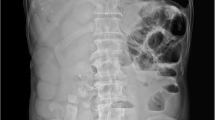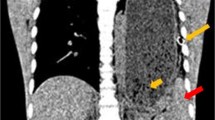Abstract
Diaphragmatic rupture occurs in 25% of blunt thoracic and abdominal trauma and is an important diagnosis to consider in the trauma setting. We report a case of a 45-year-old female driver admitted with chest and abdominal trauma following a road traffic accident who had intermittent episodes of respiratory failure needing positive pressure ventilation. No cause for her respiratory failure could be found on CT scan, Chest X-rays or ultrasound. She died on day 8 and the post mortem showed a massive diaphragmatic rupture. This delayed event makes this an unusual case. In fact it is unknown as to whether the positive pressure ventilation prevented the herniation of the intra abdominal organs into the chest masking this classical sign from the imaging investigations, or whether their was a sudden catastrophic rupture of a largely intact but badly injured diaphragm that could not be detected on the CT scan.
Résumé
Une rupture du diaphragme est présente dans 25% des cas de traumatisme non pénétrant du thorax et de l’abdomen. Nous rapportons le cas d’une femme de 45 ans avec traumatisme thoracique et abdominal à la suite d’un accident de la route. Elle développa une insuffisance respiratoire aiguë et fut mise sous ventilation à pression positive. Aucun examen d’imagerie n’identifia de cause pour cette insuffisance respiratoire. La patiente décéda 8 jours après son accident. Une autopsie mit en évidence une rupture du diaphragme. Nous ignorons si la ventilation à pression positive empêchait les organes intra abdominaux de s’engouffrer dans la cavité thoracique ou si la rupture du diaphragme se produisit quelques heures avant son décès.
Similar content being viewed by others
References
Mehdi A, Closset J, el Nakadi I, Houben JJ, Veys I, Lambilliotte JP (1995) Hernia of the diaphragm: a clinical case and review of the literature. Acta Chir Belg 95(6):281-283
Lormier JW, Reid KR, Raymond F (1994) Blunt extraperitoneal rupture of diaphragm. J Trauma 36:1414
Sola JE, Mattei P et al (1994) Rupture of right diaphragm following blunt trauma in an infant. A case report. J Trauma 36:417
Morris PJ, Malt RA 1994 Oxford textbook of surgery. Oxford University Press, New York, pp1869
Murray JG, Caoili E, Gruden JF (1996) Acute rupture of the diaphragm due to blunt trauma: diagnostic sensitivity and specificity of CT. AJR Am J Roentgenol 166:1035–1039
Killeen KL, Mirvis SE (1999) Helical CT of diaphragmatic rupture caused by blunt trauma. AJR Am J Roentgenol 173:1611–16
Beal L, Mc Kennan M (1988) Blunt diaphragm rupture. Arch Surg 123:828
Kanowitz A, Marx JA (1989) Delayed diaphragmatic hernia simulating acute tension pneumothorax. J Emerg Med 7(6):619–622
Author information
Authors and Affiliations
Corresponding author
Rights and permissions
About this article
Cite this article
Ngoga, D., Mauffrey, C. Undiagnosed delayed traumatic diaphragmatic rupture causing sudden death: case report and review of literature. Eur J Orthop Surg Traumatol 17, 321–323 (2007). https://doi.org/10.1007/s00590-006-0160-6
Received:
Accepted:
Published:
Issue Date:
DOI: https://doi.org/10.1007/s00590-006-0160-6




